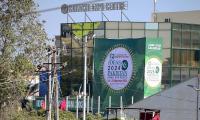MANILA: The Asian Development Bank (ADB) on Friday advised regional governments, including Pakistan to introduce policy interventions to harness technologies for better economic growth.
“Government has an important role to play in leveraging technological advances for inclusive growth,” Chief Economist Yasuyuki Sawada at ADB said.
Education and training, favourable labour regulation, social protection and tax policies are imperative for the fourth industrial revolution that is characterised by smart applications integrating virtual and physical production systems, Sawada noted in his presentation titled, ‘Asian Development Outlook 2018: how technology affects jobs’ on the second day of ADB annual meeting.
The government is advised to facilitate skills development and job-matching, invest in information and communication technology infrastructure, ensure anti-trust and consumer protection and promote innovation and technology adoption.
ADB has already expressed pessimism over Pakistan’s ability to keep up growth pace in the next fiscal year of 2019 as external imbalances are likely to contain economic expansion at 5.1 percent as compared to government’s forecast of 6.2 percent.
ADB ruled out an adverse impact of technology advancements on jobs market, but it sought policy interventions to make up for machines substituting humans.
“New technologies are not likely to cause widespread job losses in Asia,” Sawada said.
“But policy action is needed for workers to overcome challenges posed by technological advance and harness its full benefits.”
He said technological advancement drives higher productivity, the foundation for better-paid jobs and economic growth. “There are compelling reasons to remain optimistic about developing Asia’s job prospects.”
ADB’s chief economist, giving reasons behind his optimism, said new technologies often automate only some tasks of a job. The region is seeing a rise in income and demand while new occupations and industries are emerging and “technical feasibility does not guarantee economic feasibility,” he remarked.
Sawada said new technologies often involve automating specific tasks associated with a job, not the job in its entirety.
“Where robots are used, it is associated with a reduction in routine employment,” he added. “Where robots are used, it is associated with a reduction in routine employment.”
The economist found that industrial robots are concentrated in capital intensive sectors where employment shares are relatively small. Use of robots is highest in electrical and electronics and automotive industries as compared to metal, plastics and chemicals, foods and beverages, and textile sector.
Sawada further said the rising jobs demand is offsetting displacement driven by automation.
Rather, technology is also leading to new occupations but “these tend to be in non-routine cognitive category,” he added.
ADB’s chief economist, while analysing change in average monthly wages for different countries over the last couple of years, found that wages have grown for skilled workers, leaving low-skills workers behind.
An employee working at a textile factory. — AFP/FileLAHOR: Global apparel brand Primark and the All Pakistan Textile...
An undated image of gold jewellery displayed at a store. — AFP/fileKARACHI: Gold prices rose by Rs2,500 per tola on...
Senator Ilyas Ahmad Bilour at Peshawar General Hospital's Dialysis Center . — Facebook@pghphase5/fileKARACHI:...
A trader wears a hat in support of US President-elect Donald Trump, after he won the US presidential election, at the...
Chief of Treasury and Ivestment Banking U bank M Farooq Kamran, President IIPS Lt Gen Haroon Aslam, Chairman IMARAT...
Federal Minister for Maritime Affairs, Qaiser Ahmed Shaikh while addressing Global Maritime Trade Summit on November...







